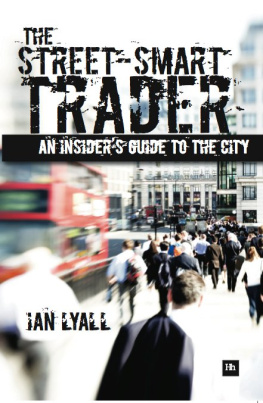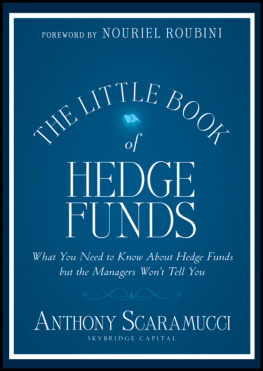Publishing details
HARRIMAN HOUSE LTD
3A Penns Road
Petersfield
Hampshire
GU32 2EW
GREAT BRITAIN
Tel: +44 (0)1730 233870
Fax: +44 (0)1730 233880
Email: enquiries@harriman-house.com
Website: www.harriman-house.com
First published in Great Britain in 2011
Copyright Harriman House Ltd
The right of Ian Lyall to be identified as the author has been asserted in accordance with the Copyright, Design and Patents Act 1988.
ISBN: 978-0-85719-100-7
British Library Cataloguing in Publication Data
A CIP catalogue record for this book can be obtained from the British Library.
All rights reserved; no part of this publication may be reproduced, stored in a retrieval system, or transmitted in any form or by any means, electronic, mechanical, photocopying, recording, or otherwise without the prior written permission of the Publisher. This book may not be lent, resold, hired out or otherwise disposed of by way of trade in any form of binding or cover other than that in which it is published, without the prior written consent of the Publisher.
No responsibility for loss occasioned to any person or corporate body acting or refraining to act as a result of reading material in this book can be accepted by the Publisher, by the Author, or by the employer(s) of the Author.
Some of the content in this book was based on interviews with City professionals, but in all cases the individuals mentioned in the book do not relate directly to any real persons. Any resemblance to real persons, living or dead, is purely coincidental. All discussion of shares, share trades and other market activity is for illustrative purposes only and may be hypothetical. Companies and illustrations have been disguised or altered to prevent compromising confidentiality; such discussion, companies and illustrations are not to be taken as factual examples, and no claims or opinions may be inferred against any company or individual based on any of the material in this book.
Images copyright iStockphoto.com
Figure data and information copyright respective owners and sources
Final figure design and presentation copyright Harriman House Ltd
Dedicated to my wonderful and very patient family.
About the Author
Ian Lyall is the editor of Proactive Investors, a champion of the independent stock market trader. Before that he was the investment editor and City news editor at the Daily Mail, where he directed the coverage of some of the biggest stories to ever emerge from the Square Mile as it struggled in the grip of the credit crunch and subsequent banking crisis.
In his 15 years as a business reporter and editor, Ian has worked for Dow Jones, writing stories for the international news wire, and the Wall Street Journal. He also led the London company coverage for AFX News, now part of Reuters.
Ians career began on local newspapers in Kent, before moving to a national news agency. His specialist areas are pharmaceuticals, biotechnology and growth stocks. A regular contributor to the Daily Mail, he writes the papers weekly investment column.
Ian lives in Hertfordshire with wife Tanya, children Oliver and Cameron and a Noahs Ark of pets including a dog, two cats, two gerbils and a pair of goldfish.
Welcome to the real City of London
What this book covers
This is an insiders guide to the City of London in the 21st century, a hub of unparalleled financial importance since the Middle Ages, and today perhaps the most significant centre of commerce in the world. The aim of The Street-Smart Trader is to take the reader behind the grand Georgian facades of the offices that line the narrow alleys of Throgmorton Street and Lothbury, and onto the trading floors of the giant glass and steel edifices of London Wall and Bishopsgate. And of course we will lead you by the hand along the swanky streets of Mayfair, home to Londons hedge fund industry, before dropping in on the new Eastenders of Canary Wharf.
If you pick up a standard textbook on the City youll be presented with the theory whats supposed to happen there. The author might tell you how all the working parts mesh together seamlessly to create one of the worlds largest capital markets. What you dont get is what really, practically happens there. Firstly, they tend to miss the context, the setting. You learn how the markets work, but not why they exist and flourish. Secondly, you rarely get the human element the fact the City is run by people and not by computers and what this actually, practically means.
Therefore, this book attempts to give a flavour of what really happens by showing the broker, the dealer and the market maker at work in their natural habitat. It is not meant to be an authoritative account of how the City of London works. It is, as the title suggests, an insiders look behind the scenes and a primer on how you can best adapt to take advantage of these overlooked facts. I hope it gives readers pause for thought, as well as fresh insights that prove of use in their own financial activities.
Who this book is for
This is a book primarily for those based outside the City who want to know what really motivates some of the main movers in the City of London and the financial markets. Those working or who hope to work within the City itself will also find this book useful (and entertaining) as it reveals what the various participants are actually up to on a day-to-day basis.
How this book is structured
The book starts by giving a potted history of the stock market from the perspective of the City. Emphasis is placed on what happened after the market liberalisation of the late 1980s, which transformed London into a fast-moving, sophisticated electronic marketplace. But there is also a look at the bygone era when the City was very much like a gentlemans club run for the benefit of its members.
In Chapters 2 and 3 we examine the inner working world of the City, including looking at the advantages professionals have over independent traders. As you will see, this deals with pitfalls and perils that confront even the most experienced traders; the scales are not always balanced. We also look at the murkier side of the stock market with the help of a few shady characters that agreed to be interviewed.
From there the guide moves on to look at the role of the markets analysts, spin doctors and financial commentators.
The focus of Chapter 6 is the role of professional traders. We look at market makers, proprietary traders and fund managers, amongst others, and some of the techniques they use as they go about their jobs.
In Chapter 7 we examine hedge funds, seeking to understand if many of the accusations levelled at them are fair and lifting the lid on techniques they use to get an advantage in the market.
We will also examine in Chapter 8 whether it is a useful exercise to scrutinise the people who run Britains listed companies to see whether their stock-picking actions should be monitored and followed.
Finally, in Chapter 9 we investigate whether mergers and takeovers really do generate the investor returns they promise.
Introduction
There is a tendency for outsiders to regard the City with suspicion. Its buildings are tall and imposing, often fenced about with elaborate security, and the language of finance used there can seem deliberately obtuse and exclusive. It seems to possess a whole set of practices and customs known only to the daytime inhabitants of a small patch of land on the eastern fringe of central London.
The inhabitants themselves are often caricatured as posh public-school types or brash Essex barrow boys out to make a few quid. That this is not the reality goes to show just how much the day-to-day business of the Square Mile is cloaked in a veil of mystery. This opacity is compounded by financial websites each day they serve up bland headlines and hours-old newswire copy that omits as much as it reveals about the City and those who work there.







